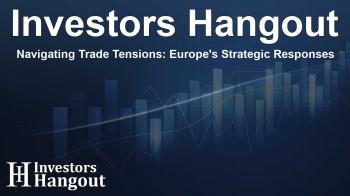Navigating Trade Tensions: Europe's Strategic Responses

Understanding US Tariffs and European Reactions
The imposition of a 25% import tax on steel and aluminum by the US has spurred trade tensions that extend to Europe. Policymakers in Europe need to consider their responses carefully. As trade barriers rise, the impact on European manufacturers becomes increasingly significant, as exports worth billions are affected.
Trade between the US and Europe is worth a considerable amount, and the latest tariffs could disrupt the flow of goods. This situation presents a complex challenge for European nations, whose industries are intricately intertwined with American markets. The pressing question remains: how will Europe respond to the evolving landscape of international trade?
Europe's Response Options
The European Commission holds the reins on foreign trade, which gives it the power to formulate responses. Yet, the lack of immediate retaliatory tools raises concerns about Europe’s capacity to respond effectively to US actions promptly.
Recently, the introduction of the EU Anti-Coercion Instrument (ACI) aims to provide a mechanism for retaliation. Nevertheless, invoking this instrument requires majority support from member states, which could take time and complicate swift action. The bureaucratic process could hinder Europe's ability to counter swiftly if the situation escalates.
What Could Retaliation Look Like?
Should the EU opt for retaliation, various strategies could be employed. For instance, imposing tariffs on goods produced in US swing states, such as soybeans and motorcycles, could target economically significant sectors for the US. This method aligns with previous responses to tariffs, whereby immediate countermeasures were enacted to maintain balance.
Moreover, Europe might consider delivering strategic export tariffs on products pivotal to US industries to leverage the negotiations further. This action, however, could lead to a reciprocal response from the US, intensifying trade tensions.
The Landscape of Trade Negotiations
Trade negotiations are complicated by the varying interests of member states. While Trump’s administration aims for advantageous deals, Europe remains cautious. During previous negotiations, promises to increase imports were made to secure concessions. However, such moves have not effectively shifted the overall trade balance.
This time around, the EU must contemplate what concessions could appease the US enough to prevent tariffs. Additional purchases, particularly in energy resources like LNG, might be on the table. However, increasing dependency on US imports raises concerns about long-term impacts on European industries.
Innovative Approaches to Strengthen Position
Beyond immediate responses, Europe's focus might shift towards strengthening its internal economy. By investing in local industries and reducing reliance on imports, Europe can better position itself against potential US trade pressures. This includes bolstering domestic manufacturing and enhancing technological capabilities, especially in sectors critical for national security.
Strategies such as joint procurement initiatives could also bolster defenses and reduce external dependency. As seen in prior collaborative efforts regarding vaccines, similar approaches for supply chains may yield benefits in crucial sectors.
Assessing Europe's Preparedness
While the EU has made strides towards preparing for an uncertain future in trade, the persistent challenge lies in swift, effective action. The interplay among member states can slow the decision-making process, which poses risks in high-stakes situations. The EU’s new economic instruments will be tested under the pressures of international trade relations.
Frequently Asked Questions
What are the main concerns regarding US tariffs on Europe?
The primary concerns revolve around the economic impact on European industries, particularly regarding exports of steel and aluminum, which could face significant barriers.
How does the EU plan to respond to US tariffs?
The EU is exploring multiple options, including potential retaliatory tariffs and seeking to strengthen internal industries to lessen dependence on imports.
What is the EU Anti-Coercion Instrument (ACI)?
The ACI is a framework established to allow the EU to respond to coercive trade practices, though it has certain limitations regarding speed and necessary member state support.
Could Europe impose tariffs on US products?
Yes, Europe can consider imposing tariffs on US products strategically targeted to leverage negotiations and assert its position in the trade discussions.
How might the EU strengthen its domestic economy?
Investments in technology and local production are critical areas for strengthening the domestic economy, reducing reliance on external suppliers, particularly in defense and technology sectors.
About The Author
Contact Kelly Martin privately here. Or send an email with ATTN: Kelly Martin as the subject to contact@investorshangout.com.
About Investors Hangout
Investors Hangout is a leading online stock forum for financial discussion and learning, offering a wide range of free tools and resources. It draws in traders of all levels, who exchange market knowledge, investigate trading tactics, and keep an eye on industry developments in real time. Featuring financial articles, stock message boards, quotes, charts, company profiles, and live news updates. Through cooperative learning and a wealth of informational resources, it helps users from novices creating their first portfolios to experts honing their techniques. Join Investors Hangout today: https://investorshangout.com/
The content of this article is based on factual, publicly available information and does not represent legal, financial, or investment advice. Investors Hangout does not offer financial advice, and the author is not a licensed financial advisor. Consult a qualified advisor before making any financial or investment decisions based on this article. This article should not be considered advice to purchase, sell, or hold any securities or other investments. If any of the material provided here is inaccurate, please contact us for corrections.

